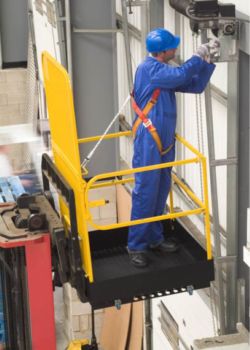
While touring a large retail warehouse recently, I spotted something that motivated me to ask our tour guide about the training their forklift operators received. She went into great detail with an obvious sense of pride about the operator training program in place at the facility and their efforts at maintaining it on an ongoing basis beyond the completion of initial the training. For the most part, her pride was well deserved; they had it covered from initial through refresher and upgrade training, and they even had a system in place that picked up remedial training when incidents and/or near-miss incidents occurred.
When I asked her how the operators’ fall protection training was handled she stared at me in silence for an uncomfortably long period, as the others in the tour group did, and finally asked why on earth forklift operators would need fall protection. I answered her by reporting what I spotted earlier, which was a fall protection harness connected and self-retracting lanyard (SRL) left attached to the anchor point of an order-picker (see photo), presumably by the last operator to use it. This is a real no-no in the fall protection world, at least in my humble opinion. I won’t go into detail on the conversation (or lack thereof) between myself and the tour guide from that point on. Suffice to say that fall protection training had not made it onto the agenda for their order picker operators. However, this experience raised a larger issue; certain forklift operators at this particular location were not being fully trained for the type of equipment they were using.
An order picker is a unique machine that straddles the defining line between powered industrial trucks (forklifts) and aerial lifts in that this hybrid machine is not only used as a materials handler, but as a personnel elevating device as well. This is because when the forks are raised on an order-picker, the platform on which the operator stands also rises with them. Since the platform is not enclosed by guardrails, operators must use a personal fall protection system and the popular choice is a full body harness connected to a self-retracting lanyard.
The fall protection world is an extremely broad and far reaching one and, in context, the amount of training needed for an order picker operator is a sliver of what a construction worker on a tower erection crew might have to receive. However, regardless of the application, any worker who is required to work at height must receive fall protection training that, at the very least, provides the user with the knowledge and ability to correctly select, inspect, don, use and store his or her fall protection equipment properly in addition to all the training required to operate the forklift properly.
The amount of fall protection training required varies but it in any case, it is well worth the time to check occupational safety and health regulatory requirements in your region to find out what is needed. Some regulatory jurisdictions have relatively stringent requirements compared to others but they all require something. Considering the high placement that fall-related incidents regularly receive year over year in every statistical category that matters such as, injuries, fatalities, citations and overall incidents, you can imagine the priority that regulatory authorities give to fall protection training and such if they ever have occasion to find themselves at your workplace. Given the tragic toll that fall related incidents take annually in workplaces all over the world, the priority given to their prevention is certainly not misplaced so if you use order pickers, I strongly suggest that you give it some priority too.
Rob Vetter
Director of Training
IVES Training Group
Did you enjoy this article? Sign up for our newsletter to receive more like this!